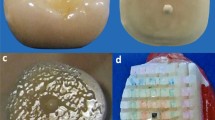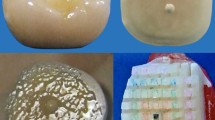Abstract
Purpose
There is limited evidence regarding the most appropriate type of luting cement for paediatric prefabricated zirconia crowns (PZCs) in primary maxillary incisors. The retention of PZCs is dependent on the bond strength of luting cement between PZCs and primary maxillary incisors. The aim of this study was to evaluate the tensile bond strengths between PZCs and primary maxillary incisors with different types of luting cements.
Methods
Thirty freshly extracted human primary maxillary incisors were prepared and randomly divided into three groups corresponding to three luting cements: bioactive cement, resin cement, and resin-modified glass ionomer cement (RMGIC), and then restored with PZCs. Tensile bond strengths were evaluated by a universal testing machine. The results were analysed using one-way ANOVA with Tukey’s post-hoc test (p < 0.05).
Results
The means of the tensile bond strengths were 1.43 ± 0.85 MPa, 0.91 ± 0.63 MPa, and 0.56 ± 0.39 MPa for the bioactive cement, resin cement, and RMGIC groups, respectively. A significant difference in tensile bond strength was observed between the bioactive cement and the RMGIC group (p < 0.05) but there was no significant difference in tensile bond strength between the resin cement group and the others.
Conclusion
Types of luting cement influenced the tensile bond strength between PZCs and primary maxillary incisors. The bioactive cement showed higher tensile bond strength than the resin cement and RMGIC.




Similar content being viewed by others
Data availability
The data supporting this study’s findings are not publicly available due to privacy and ethical considerations. However, specific data inquiries can be addressed upon reasonable request to the corresponding author.
References
Al-Haj Ali SN, Farah RI. In vitro comparison of microleakge between preformed metal crowns and aesthetic crowns of primary molars using different adhesive luting cements. Eur Arch Paediatr Dent. 2018;19:387–92. https://doi.org/10.1007/s40368-018-0369-1.
Alrashdi M, Ardoin J, Liu AJ. Zirconia crowns for children: A systematic review. Int J Paediatr Dent. 2021;32:66–81. https://doi.org/10.1111/ipd.12793.
André CB, Aguiar TR, Ayres AP, Ambrosano GM, Giannini M. Bond strength of self-adhesive resin cements to dry and moist dentin. Braz Oral Res. 2013;27:389–95. https://doi.org/10.1590/s1806-83242013000500002.
Azab MM, Moheb DM, El Shahawy OI, Rashed MAM. Influence of luting cement on the clinical outcomes of zirconia pediatric crowns. A 3-Year Split-Mouth Randomized Controlled Trial. Int J Paediatr Dent. 2020;30:314–22. https://doi.org/10.1111/ipd.12607.
Baig MS, Fleming GJ. Conventional glass-ionomer materials: a review of the developments in glass powder, polyacid liquid and the strategies of reinforcement. J Dent. 2015;43:897–912. https://doi.org/10.1016/j.jdent.2015.04.004.
Blatz MB, Sadan A, Kern M. Resin-ceramic bonding: a review of the literature. J Prosthet Dent. 2003;89:268–74. https://doi.org/10.1067/mpr.2003.50.
Chopra S, Bansal P, Vilekar AM, Aatish S, Sultan M, Uppal RS. Evaluating the solubility of various dental cements in artificial saliva in different mediums at different time intervals: In-Vitro Study. Eur J Mol Clin Med. 2021;7:4692–701.
Clark L, Wells MH, Harris EF, Lou J. Comparison of amount of primary tooth reduction required for anterior and posterior zirconia and stainless steel crowns. Pediatr Dent. 2016;38:42–6.
Cohn C. Zirconia-prefabricated crowns for pediatric patients with primary dentition: Technique and Cementation for Esthetic Outcomes. Compend Contin Educ Dent. 2016;37:554–8.
Davis Jr C. Retentive cement strengths with passive fit primary anterior esthetic crowns. VCU Scholars Compass. 2012. https://doi.org/10.25772/Y28Z-0114.
Ernst CP, Cohnen U, Stender E, Willershausen B. In vitro retentive strength of zirconium oxide ceramic crowns using different luting agents. J Prosthet Dent. 2005;2005(93):551–8. https://doi.org/10.1016/j.prosdent.2005.04.011.
Gosnell ES, Thikkurissy S. Management of dental caries and esthetic issues in the pediatric patient. J Calif Dent Assoc. 2013;41:619–29.
Hirayama A. Experimental analytical electron microscopic studies on the quantitative analysis of elemental concentrations in biological thin specimens and its application to dental science. Shikwa Gakuho. 1990;90:1019–36.
Holsinger DM, Wells MH, Scarbecz M, Donaldson M. Clinical evaluation and parental satisfaction with pediatric zirconia anterior crowns. Pediatr Dent. 2016;38:192–7.
Jing L, Chen JW, Roggenkamp C, Suprono MS. Effect of crown preparation height on retention of a prefabricated primary posterior zirconia crown. Pediatr Dent. 2019;41:229–33.
Kachhara S, ARiga P, Jain AR. Recommended cementation for monolithic zirconia crowns. Drug Invent Today. 2018;10:566–568.
Kessler A, Kapor S, Erdelt K, Hickel R, Edelhoff D, Syrek A, Güth JF, Kühnisch J. Two-body wear and fracture behaviour of an experimental paediatric composite crown in comparison to zirconia and stainless steel crowns dependent on the cementation mode. Dent Mater. 2021;37:264–71. https://doi.org/10.1016/j.dental.2020.11.010.
Kim SY, Shin Y, Kim Ik-H, Song JS. In Vitro Study on the Bond Strength Between 3D-Printed Resin and Resin Cement for Pediatric Crown Restoration. J Korean Acad Pediatr Dent 2023;50:104–12. https://doi.org/10.5933/JKAPD.2023.50.1.104
Krithikadatta J, Gopikrishna V, Datta M. CRIS Guidelines (Checklist for Reporting In-vitro Studies): A concept note on the need for standardized guidelines for improving quality and transparency in reporting in-vitro studies in experimental dental research. J Conserv Dent. 2014;17:301–4. https://doi.org/10.4103/0972-0707.136338.
Lad PP, Kamath M, Tarale K, Kusugal PB. Practical clinical considerations of luting cements: A review. J Int Oral Health. 2014;6:116–20.
Lin B, Khatri A, Hong M. Comparison of Fracture Strengths among different Commonly Placed Anterior Esthetic Restorations for Primary Dentition: An in vitro study. J Clin Pediatr Dent. 2021 Jul 1;45:171–76.https://doi.org/10.17796/1053-4625-45.3.5
Manicone PF, Iommetti PR, Raffaelli L. An overview of zirconia ceramics: basic properties and clinical applications. J Dent. 2007;35:819–26. https://doi.org/10.1016/j.jdent.2007.07.008.
NuSmile®. BioCem Universal BioActive Cement. BioCem White Paper Booklet v2_EMAIL.pdf. Accessed December 25, 2021.
Özcan M, Bernasconi M. Adhesion to zirconia used for dental restorations: a systematic review and meta-analysis. J Adhes Dent. 2015;2015(17):7–26. https://doi.org/10.3290/j.jad.a33525.
Pameijer CH. A review of luting agents. Int J Dent. 2012: 752861–61. https://doi.org/10.1155/2012/752861.
Pires CW, Soldera EB, Bonzanini LIL, Lenzi TL, Soares FZM, Montagner AF, Rocha RO. Is adhesive bond strength similar in primary and permanent Teeth? A systematic review and meta-analysis. J Adhes Dent. 2018;20:87–97. https://doi.org/10.3290/j.jad.a40296.
Rosato L, Chen J-W, Roggenkamp C, Su J-M. Retentive strengths for prefabricated primary molar zirconia crowns using five different cements. TJPD. 2018;18:127–35. https://doi.org/10.6319/TJPD.201809_18(4).0001.
Salami A, Walia T, Bashiri R. Comparison of parental satisfaction with three tooth-colored full-coronal restorations in primary maxillary incisors. J Clin Pediatr Dent. 2015;39:423–8. https://doi.org/10.17796/1053-4628-39.5.423.
Scaminaci Russo D, Cinelli F, Sarti C, Giachetti L. Adhesion to zirconia: A systematic review of current conditioning methods and bonding materials. Dent J (basel). 2019;7:74. https://doi.org/10.3390/dj7030074.
Stepp P, Morrow BR, Wells M, Tipton DA, Garcia-Godoy F. Microleakage of cements in prefabricated zirconia crowns. Pediatr Dent. 2018;40:136–9.
Subsomboon T, Yavirach P, Chaijareenont P. Effect of different surface treatments on shear bond strength of zirconia Y-TZP bonded with resin cement. CM Dent J. 2018;39:31–46.
Waggoner WF. Restoring primary anterior teeth: Updated for 2014. Pediatr Dent. 2015;37:163–70.
Walczak K, Rues S, Wieckiewicz M, Range U, Schmitter M. Is mechanical retention for adhesive core build-up needed to restore a vital tooth with a monolithic zirconium crown? - An in vitro study. Acta Bioeng Biomech. 2016;18:117–25.
Yanover L, Tickotsky N, Waggoner W, Kupietzky A, Moskovitz M. Zirconia crown performance in primary maxillary anterior teeth: a retrospective photographic and radiographic cohort study. Eur Arch Paediatr Dent. 2021;22:417–23. https://doi.org/10.1007/s40368-020-00571-5.
Acknowledgements
We would like to thank Faculty of Dentistry, Chiang Mai University for research funding and financial support. We appreciate Dr. Pokpong Amornvit and Mr. Chakrit Wiboonsuntharangkoon for their valuable recommendations how to use the surface calculation program, Dental Material Science Laboratory (Faculty of Dentistry, Chiang Mai University) for laboratory work, and Dr. Thanapat Sastraruji, Dental Research Center, Faculty of Dentistry, Chiang Mai University for statistical consultant. We wish to thank Mr. Martin Clutterbuck for his assistance in the preparation of the manuscript.
Funding
The research leading to these results received funding from Faculty of Dentistry, Chiang Mai University, Thailand. All authors certify that they have no affiliation with or involvement in any organization or entity with any financial interest or non-financial interest in the subject matter or materials discussed in this manuscript.
Author information
Authors and Affiliations
Contributions
Parichat Pengpue collected the data, analysed the data and writing, Varisara Sirimaharaj writing, Pisaisit Chaijareenont conceived the ideas, Wannapa Chinadet conceived the ideas, led the writing.
Corresponding author
Ethics declarations
Conflict of interest
The authors declared no potential conflicts of interest with respect to the research, authorship and or publication of this article.
Informed consent
Written informed consent was obtained from each legal guardian before tooth extraction. Tensile bond strength between paediatric prefabricated zirconia crowns and primary maxillary incisors when using various types of luting cements: An in vitro study.
Additional information
Publisher's Note
Springer Nature remains neutral with regard to jurisdictional claims in published maps and institutional affiliations.
Rights and permissions
Springer Nature or its licensor (e.g. a society or other partner) holds exclusive rights to this article under a publishing agreement with the author(s) or other rightsholder(s); author self-archiving of the accepted manuscript version of this article is solely governed by the terms of such publishing agreement and applicable law.
About this article
Cite this article
Pengpue, P., Sirimaharaj, V., Chaijareenont, P. et al. Tensile bond strength between paediatric prefabricated zirconia crowns and primary maxillary incisors when using various types of luting cements: an in vitro study. Eur Arch Paediatr Dent (2024). https://doi.org/10.1007/s40368-024-00890-x
Received:
Accepted:
Published:
DOI: https://doi.org/10.1007/s40368-024-00890-x




